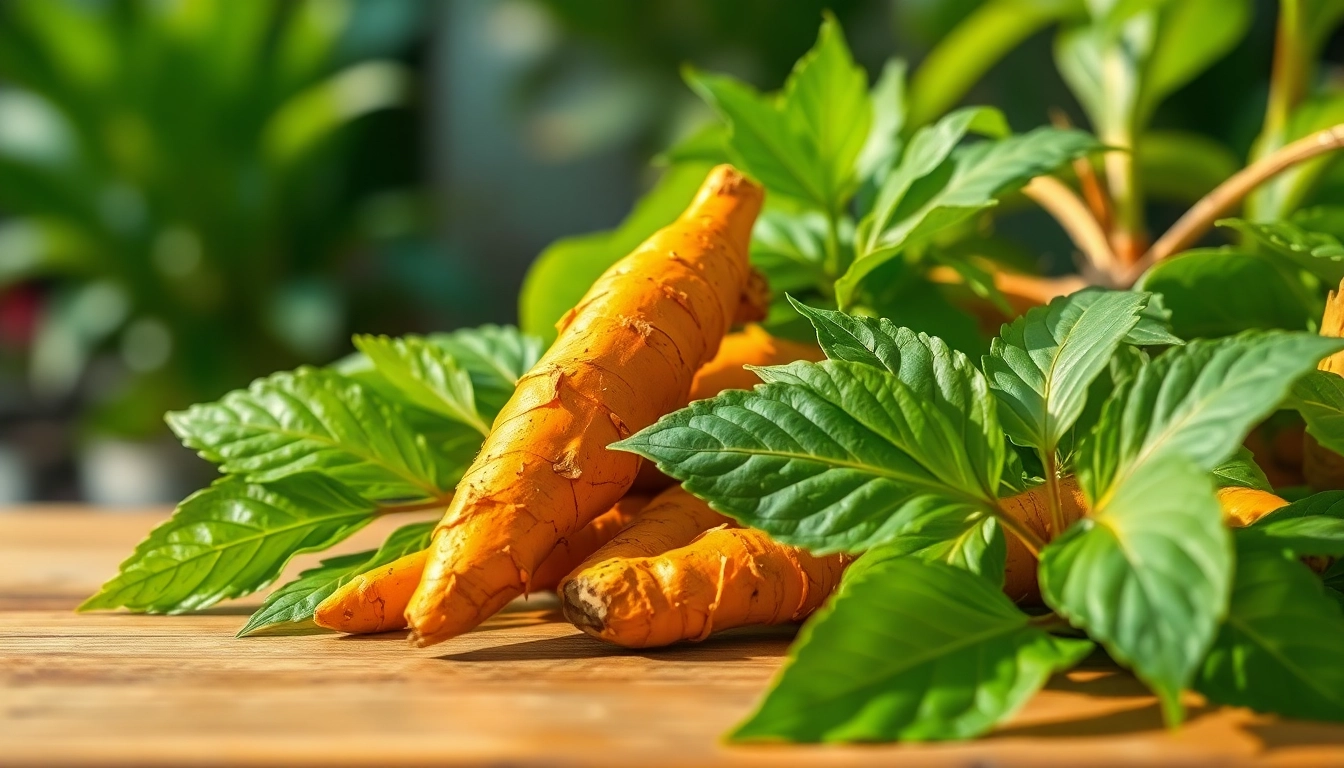The Comprehensive Benefits of Turmeric Root: Health, Uses, and Culinary Tips
Understanding Turmeric Root: Origins and Nutritional Profile
What is Turmeric Root?
Turmeric root, derived from the rhizome of the Curcuma longa plant, is a vibrant golden-yellow root closely related to ginger. This spice has earned a prominent place in culinary traditions and alternative medicine around the world, particularly in Asia. It has been heralded not only for its unique flavor and color but also for its powerful health benefits. Traditionally, turmeric root has served as a core ingredient in Ayurvedic practices, contributing to wellness protocols for centuries.
Historical Uses in Traditional Medicine
The historical use of turmeric root traces back thousands of years in various cultures. In India, Ayurveda has long incorporated turmeric for its healing properties, utilizing it to treat conditions ranging from digestive issues to skin ailments. Similarly, Traditional Chinese Medicine (TCM) recognizes the anti-inflammatory and therapeutic potential of turmeric, endorsing it for the treatment of joint pain and digestive problems. Its reputation extends globally, often being regarded as a natural remedy for ailments, and its application has only increased with ongoing scientific studies corroborating its benefits.
Nutritional Content of Turmeric Root
Turmeric root is not only recognized for its flavor but also for its rich nutritional profile. The primary active component of turmeric, curcumin, is well-studied for its anti-inflammatory and antioxidant properties. One tablespoon (approximately 7 grams) of dried turmeric root contains:
- Calories: 24
- Carbohydrates: 5.1 grams
- Protein: 0.5 grams
- Fat: 0.7 grams
- Fiber: 1.4 grams
- Vitamin C: 0.7 mg (1% DV)
- Iron: 0.6 mg (3% DV)
- Curcumin content: Typically 3-5% by weight
This nutrient density, particularly the presence of curcumin, contributes to the various health benefits associated with turmeric root, making it a valuable addition to a health-conscious diet.
Health Benefits of Turmeric Root
Anti-inflammatory Properties
Curcumin, the primary active compound in turmeric, is known for its potent anti-inflammatory effects. Chronic inflammation is a significant factor in many health issues, including arthritis, heart disease, and cancer. Research indicates that curcumin can inhibit various molecules associated with inflammation, thereby offering potential relief for individuals suffering from inflammatory conditions. A study published in the Journal of Alternative and Complementary Medicine highlights that curcumin supplementation leads to significant reductions in inflammation markers in patients suffering from chronic inflammatory diseases.
Potential Cancer-Fighting Benefits
Studies have increasingly shown that curcumin possesses anti-cancer properties. It has been shown to affect cancer growth at a molecular level, disrupting the cell cycle and preventing cells from proliferating uncontrollably. Notably, research published in the journal Cancer Letters indicates that curcumin can induce apoptosis (programmed cell death) in various cancer types, including breast, colon, and prostate cancers. While more research is needed to define its efficacy fully, its implications in cancer therapy appear promising.
Effects on Mental Health and Mood
The benefits of turmeric root extend beyond physical health into the realm of mental wellbeing. Studies suggest a link between curcumin and improvements in mood and cognitive function. A randomized controlled trial published in the Journal of Affective Disorders demonstrated that curcumin supplementation significantly improved mood in individuals diagnosed with major depressive disorder. This effect is attributed to curcumin’s ability to increase levels of brain-derived neurotrophic factor (BDNF), a protein that supports neuron growth and function. Maintaining healthy BDNF levels can help reduce the risk of cognitive decline and improve overall emotional wellbeing.
Incorporating Turmeric Root Into Your Diet
Ways to Use Fresh Turmeric Root in Cooking
Fresh turmeric root can be an engaging addition to various culinary dishes due to its earthy flavor and vibrant color. It can be used in:
- Teas: Grate fresh turmeric into boiling water, steep for a few minutes, add honey or lemon for flavor.
- Smoothies: Blend fresh turmeric with fruits, vegetables, and protein powders to create a nutritious wellness drink.
- Soups and Stews: Add grated turmeric to your favorite soup or stew recipes for a health boost and flavor enhancement.
- Curries: Fresh turmeric is a staple in curries, providing a deep yellow color and a unique flavor. Use it alongside other spices for a rich dish.
- Meat Marinades: Incorporate turmeric in marinades for meats to impart flavor and health benefits.
Its versatility allows it to fit seamlessly into various cuisines, encouraging both health benefits and culinary adventure.
Creating Turmeric Infused Beverages
Turmeric-infused beverages, like golden milk or turmeric lattes, have gained popularity for their health benefits and delicious taste. To prepare a simple golden milk, combine:
- 1 cup of milk (or a non-dairy alternative)
- 1 teaspoon of grated fresh turmeric or 1/2 teaspoon of turmeric powder
- 1/4 teaspoon of black pepper (to enhance curcumin absorption)
- Optional sweeteners like honey or maple syrup
Heat all ingredients in a saucepan, stirring to blend, and enjoy warm. This drink not only uplifts your mood but also offers soothing properties for digestion and inflammation.
Dosage Recommendations for Supplements
While incorporating turmeric root into meals is beneficial, many people opt for supplementation to achieve higher doses of curcumin for therapeutic effects. A common recommendation for curcumin supplementation ranges from 500 mg to 2,000 mg per day, often broken into several doses. However, it’s essential to consult with a healthcare professional before starting any new supplement regimen, especially for individuals who are pregnant, nursing, have underlying health conditions, or are taking medications.
Possible Side Effects of Turmeric Root
Understanding Safe Consumption Levels
For most individuals, turmeric is safe when used in cooking; however, excessive intake of turmeric supplements can lead to side effects such as:
- Gastrointestinal distress
- Nausea and diarrhea
- A risk of bleeding disorders due to blood-thinning properties
Generally, it is recommended not to exceed 4-5 grams of turmeric powder per day in culinary use, and caution is advised when consuming high doses of curcumin supplements.
Interactions with Medications and Other Herbs
Turmeric and its active compounds may interact with several medications. Notable interactions include:
- Blood thinners: Turmeric may enhance the effects of anticoagulant medications, increasing the risk of bleeding.
- Stomach acid reducers: Turmeric might interfere with the effectiveness of certain medications aimed at reducing stomach acid.
- Diabetes medications: Turmeric may affect blood sugar levels, potentially interfering with diabetes management.
Healthcare professionals should always be consulted to avoid potential interactions.
When to Avoid Turmeric Root
While turmeric root is a healthy addition for many, certain individuals should exercise caution:
- Pregnant or breastfeeding women should avoid high doses due to potential hormonal effects.
- People with bile duct obstruction or gallstones should consult their doctor, as turmeric can stimulate bile production.
- Those scheduled for surgery should discontinue turmeric supplements at least two weeks prior to avoid increased bleeding risks.
Awareness of these factors can help ensure safe and effective use of turmeric root in both culinary and medicinal contexts.
Shopping for Quality Turmeric Root
Choosing Between Fresh and Powdered Turmeric
When shopping for turmeric, consumers can choose between fresh or powdered forms. Fresh turmeric root can be found in health food stores, while powdered turmeric is widely available in grocery stores. Here are some factors to consider when choosing:
- Flavor: Fresh turmeric has a more potent and vibrant flavor, ideal for cooking.
- Convenience: Powdered turmeric offers convenience and ease of use, suitable for seasoning and supplements.
- Curcumin content: Fresh turmeric typically has a higher curcumin concentration than powdered forms.
Ultimately, the choice between fresh and powdered turmeric will depend on personal preference, usage requirements, and accessibility.
Where to Buy Quality Turmeric Root
Quality turmeric can be purchased from health food stores, specialty spice shops, and online retailers. When selecting turmeric, look for:
- Organic certification if possible, to avoid pesticides and chemical fertilizers.
- Vibrant color—fresh turmeric should be a deep orange-yellow, while powdered forms should not appear dull or faded.
- Freshness—check the packaging date on supplements to ensure potency.
Ensuring the quality of your turmeric will significantly impact its flavor and health benefits.
Storing Turmeric Root for Longevity
Proper storage is crucial to preserving the freshness and efficacy of turmeric root. Here are some tips for keeping your turmeric in optimal condition:
- Fresh turmeric: Store in the refrigerator wrapped in a paper towel inside a plastic bag to avoid moisture build-up.
- Powdered turmeric: Keep in an airtight container, in a cool, dark place, away from moisture and heat.
When stored correctly, fresh turmeric can last for several weeks, while powdered turmeric can retain its potency for up to two years.














Post Comment